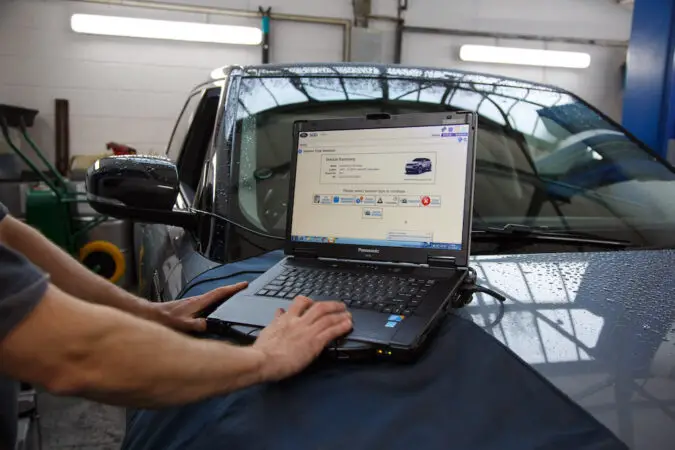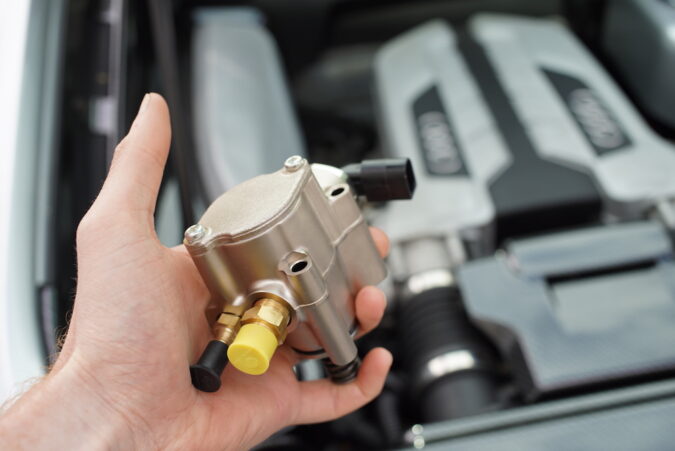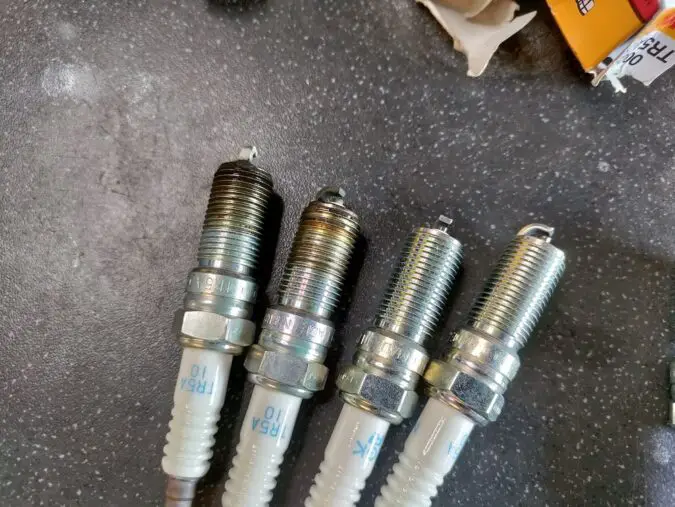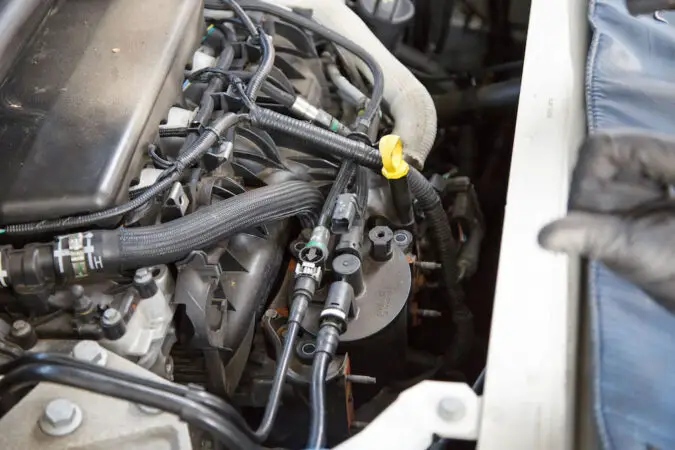Technological advancement and innovative design have made the vehicle of today more efficient than older ones. Today’s cars use advanced sensors to detect faults which they identify as codes like the P0300 Nissan. The 1970s’ strict emissions standards caused a thorough review of vehicle powertrain design, which led to the introduction of on-board diagnostics (OBD). If the SES (Service Engine Soon) light illuminates, the computer alerts you to a problem.
Your vehicle drives when fuel is consumed, and power is generated inside the cylinder chamber. Most engines feature four, six, or eight cylinders, each firing a spark plug continuously and smoothly. Pistons roll up and down as gasoline is kindled at precise intervals to produce power.
When there is a misfire, the engine speed fluctuates. The varying speed makes the crankshaft position (CKP) sensor change. The engine control unit (ECU) receives and interprets the signals. This signal tells how the engine control unit controls the fuel injection and ignition system timing. Misfires occur when the ignition timing is incorrect, and the spark plug isn’t firing.
P0300 Nissan indicates that two or more cylinders are misfiring. It is a cause for concern and calls for urgency to repair because it is dangerous to drive a car with a P0300 error code. This article discusses P0300 Nissan on vehicle performance and how to avoid it for a safe drive.
- What is the P0300 Nissan code?
- What is Engine Misfire?
- What Causes Multiple Cylinder Misfire?
- How To Fix Multiple Cylinder Misfire
- How To Diagnose Nissan P0300
- Can You Drive With P0300 Nissan
- How Much Does It Cost To Fix P0300 Nissan?
- How To Avoid The P0300 Nissan 350z?
- Final Thoughts
- FAQs
Nissan P0300 Random Cylinder Misfire
P0300 is an abbreviation for “Random, Multiple Cylinder Misfire Detected.” The code indicates that one or more engine cylinders are misfiring. This code will not tell you which cylinder is causing the misfire. You’ll have to examine each cylinder to find out. If more than one cylinder misfires, the crankshaft’s revolutions per minute (RPM) will increase or decrease.
The P0300 code will activate and be stored by the powertrain control module (PCM) if it exceeds 2%. The P0301-P0308 codes accompany it and would help you detect that faulty cylinder. Always check out for these extra codes accompanying the P0300 error code to help you properly diagnose the faulty cylinder.
P0300 Random Multiple Cylinder Misfire Detected
When the amount of fuel burning in the cylinder is insufficient, the engine misfires. Proper fuel combustion is critical for the engine’s proper operation, and the energy released from burning fuel powers the engine. The engine control module (ECM) monitors the misfire using both the camshaft and crankshaft position sensors. The camshaft position sensor detects a misfiring cylinder, while the crankshaft position sensor measures variations in the crankshaft rotation speed sensor.
Misfire codes show that a cylinder has a misfire, and the last number indicates which cylinder has the problem. If there is a misfire in a random number of cylinders, the car’s computer will detect a P0300 misfire code.
Multiple Cylinder Misfire Causes
Many factors can contribute to the P0300 random multiple cylinder misfire being detected. It could be because of a bad ignition system, faulty fuel system, or an internal engine failure. A worn spark plug can also cause multiple cylinder misfires, especially if your car has been faulty or hasn’t been serviced for a long time.
1. Faulty Or Worn Spark Plugs
The spark plug produces a spark in the combustion chamber, igniting the air/fuel mixture that powers your engine. An old spark plug would pose a safety risk or damage your engine in a severe case. Vehicles with faulty spark plugs may experience a rough or loud idle and may or may not vibrate. Also, this occurs as a result of unburned fuel from misfires. Faulty spark plugs cause the misfire, which confuses the O2 sensors. But, waiting too long may result in decreased reliability or cause a halt by the roadside.
2. Ignition Problems, Such As Faulty Ignition Coils
When you apply the brakes or speed up, a faulty ignition coil will cause an engine to misfire. A misfire can cause your car to shut down while you’re driving in an extreme case. The emission impairs the catalytic converter and other engine components.
As an electronic engine management component, the ignition coils of the ignition system transform the vehicle’s 12-volt output into 20,000 volts. The engine air-fuel mixture requires an electrical spark to ignite it, and this voltage helps achieve it.
3. Failure Of The Distributor
For the ignition system to function well, it is important to keep the engine distributor operating at peak efficiency because it distributes current from the ignition coil to the engine’s spark plugs.
4. Faulty Fuel Injection Pump
Fuel pumps and injectors check your engine’s fuel-air mixture. A stuttering idling sound and engine misfiring can result from dirty fuel injectors. This issue causes the motor to stumble, causing vibrations throughout the vehicle. Invest in a simple cleaning of your dirty fuel injectors as it helps you return to a smooth ride and enjoy a cool drive.
5. Vacuum Leak
If your Nissan’s vacuum leak, it may struggle to achieve the proper fuel-air mixture leading to engine misfires. Most times, you’ll get a P0300 code instead of other accompanying misfire codes. Vacuum leaks occur downstream of the mass airflow sensor (MAF).
A leak as small as 0.020 inches can cause P0300 in the Nissan Frontier. A leak can degrade engine performance and cause your check engine light to illuminate. A leaking intake manifold gasket, a broken PCV valve, disconnected vacuum line cause a vacuum leak.
6. Low Fuel Pressure
Insufficient fuel delivered to your car engine will make combustion less than optimal. Low fuel pressure can be difficult to diagnose. Also, if you have low fuel pressure, the vehicle will continue to run even when it doesn’t need a lot of fuel. However, at high speeds or under heavy acceleration, it will sputter and almost stop.
7. Faulty Camshaft Or Crankshaft Sensors
This is not common but can happen when the ECU does not receive a signal from the camshaft and crankshaft sensors. This can turn off the engine timing resulting in a misfire, and popping the P0300 Nissan code.
8. Engine Timing Turned Off
If the engine timing of the camshaft is incorrect, your car will not function well or not function at all. Moreover, it has four cycles, so it is more difficult to detect if the ignition timing is off. A worn engine timing belt can affect the engine’s firing rate. The engine timing belt will occasionally slip, and this causes one of the cylinders to open and close faster than it should, resulting in misfiring. If the engine timing belt is not replaced as soon as possible, catastrophic damage can occur.
9. Head Gasket Leak
A head gasket that fails between cylinders usually results in a misfire and a few other symptoms. Coolant may leak into a cylinder if the head gasket between the cylinder and the coolant port fails.
This leads to misfires on startup, especially after the engine has been run, turned off, and restarted. A compression test may not reveal this type of failure. Pressing the cooling system and then starting the car engine may amplify the misfire.
10. Engine Compression Is Low
Because of low compression or coolant in the cylinder, one or more cylinders may be misfiring. The compression of a cylinder reduces when a failed head gasket allows compressed air/fuel to escape. This loss of compression causes the engine to run rough and significantly reduces engine power.
11. EGR (Exhaust Gas Recirculation) Issues
The EGR valve serves only one purpose. It reduces the number of NOx pollutants (nitrogen) emitted by your vehicle. Recirculating some of the emissions back into the combustion chambers rather than emitting them helps achieve this. The P0300 triggers if the EGR system cannot recycle the engine gasses.
12. Poor Quality, Old, Or Contaminated Fuel
The fuel filter is a physical barrier between the impurities in gasoline and your vehicle’s engine. Suppose you have a dirty fuel filter or one that can’t do its job well because it’s damaged or clogged. Contaminants will find their way into the engine and cause expensive damage. It limits the amount of fuel that enters the engine.
When this happens, the engine loses power, and the vehicle’s functionality suffers. The simplest solution is to replace your fuel filter.
Mechanical Issues That Cause Multiple Misfires
Mechanical faults that result in multiple misfires can be
- The head gasket is leaking
- Valves that aren’t working
- A faulty piston ring
- Valve guides that are worn out
- A charred valve
- As a result, the engine will run at an abnormally low revolution per minute (RPM)
How To Fix Multiple Cylinder Misfire
Many variables result in a cylinder misfire—screwdrivers, FIXD, digital multimeter, 5/8in. Spark plug sockets, ratchet, sockets, extensions, fuel pressure gauge, compression tester, leak down tester, spark plugs and spark plug wires are all required for repair. You may find it hard to detect the problem’s source. The most logical thing is to take your car to the mechanic.
If you aren’t used to these kinds of repairs, consult your car manufacturer’s manual to successfully diagnose and fix the problem. Follow the steps below for the correct diagnosis if you want to try to fix problem P0300 at home without spending money on parts. Keep in mind that this is an advanced-level diagnosis and repair unsuitable for beginners.
How to Fix P0300 Nissan #1 – Check For The Accompanying Codes
Scan your car to detect all the error codes resulting from the fault. If you detect only the Nissan P0300, proceed with the fix. If there are any other codes, try to fix them first.
How To Fix P0300 Nissan #2 – Check The Ignition Wiring And Connectors
You have to scan through your car’s connections and ignition wiring system to detect any loose connectors or wires. Once seen, fix them and replace bad connectors fast. Because that can cause multiple cylinder misfires resulting in P0300 Nissan.
How To Fix P0300 Nissan #3 – Check The Spark Plugs
Check the spark plugs in the cylinders to know if any of them is bad or worn. Bad spark plugs can cause engine misfires and you should change them to avoid further issues.
How To Fix P0300 Nissan #4 – Inspect The Fuel Pump
Multiple engine misfires can happen when the fuel system supplies gas at low pressure to the engine. The fuel pump whether mounted inside or outside the fuel tank is responsible for supplying sufficient gas to the engine. Service or replace the fuel pump to get the issue fixed.
How To Fix P0300 Nissan #5 – Inspect The Fuel System
A bad fuel injection system can result in engine misfires. Once you are done with checking the ignitions and spark plugs and the problem persists, check the fuel system. When the fuel system isn’t supplying enough fuel, engine misfires may happen to result in the P0300 Nissan.
How To Fix P0300 Nissan #6 – Diagnose The Fuel Injector
A bad fuel injector can cause the Nissan P0300 error code. Replace or service a faulty fuel injector to get your car in good working condition.
How To Fix P0300 Nissan #7 – Run A Compression And Leakdown Test On The Engine
You can run these tests if the fuel systems and the ignitions are in good shape. They will help you detect mechanical faults. That will tell if the Nissan P0300 error code result from a mechanical issue.
How To Diagnose Nissan P0300
Many factors trigger the P0300 random cylinder misfire trouble code. Some of the most common symptoms associated with code P0300 Nissan models such as the Frontier, Altima, Murano, Maxima, Xterra, 350z, and Pathfinder include:
1. Slow Acceleration
One of two things may be wrong when you are driving your car, and you are losing power as you speed up. A lack of gasoline or a lack of power could be the cause of your vehicle’s problems.
2. The Check Engine Light Illuminates Or Flashing
From a loose gas cap to a misfiring engine, there are many reasons the engine light is on. When your check engine light illuminates or a P0300 triggers, it signifies the computer has identified a problem. The OBD2 system maintains the diagnostic trouble code connected with that malfunction.
3. Jerking While Accelerating
Your car loses power when you try to accelerate from a stop and maintain a constant pace. It’s common for lack of enough air, fuel, or spark to cause a car to jolt, surge, buck, or stutter when you press the gas pedal.
4. The Engine Refuses To Start At All
For the engine to start, it needs enough fuel pressure, a timed spark, and normal compression. One of these systems is usually the cause when it doesn’t start. Although, the starter system can also contribute to your car’s refusal to start.
5. Starting The Engine Is Difficult
A tough time starting the car is a sure sign of a blocked fuel filter. As a result, the fuel does not atomize as it enters the combustion chamber due to a lack of fuel pressure. The first place to search is usually not your car’s clogged fuel filter to get your car started. We recommend you check the ignition system first if you don’t have any fuel pressure or oxygen sensors issue codes. Again, a faulty coil pack or poor spark plugs can also be why your car isn’t starting.
6. The Engine Runs Rough And The Car Shakes
When a car shakes while driving, it often means something different than when it vibrates when stopped. Nevertheless, It is necessary to pay attention to when the shakes occur.
7. Increase In Fuel Consumption
In a serious misfire, the cylinder’s power contribution is insignificant, resulting in reduced engine power. Fuel consumption and gas mileage will suffer because hard work will be on the cylinder to match the driver’s demand for power.
8. Exhaust Fuel Smell
When we have much air or very little air entering the combustion chambers, it causes an exhaust odor. Injector damage, leakage, blocked air filters, and defective mass airflow sensors can contribute to this.
P0301, P0302, P0303, P0304, P0305, P0306, P0307, and P0308 are often associated with error codes.
Can I Drive With Code P0300 Nissan?
Driving with a misfiring engine can cause greater damage. When a cylinder misfires, unburned fuel might melt the catalytic converter. This is an expensive part of the pollution control system. A vehicle with a P0300 trouble code can cause the engine shut down without warning.
Some manufacturers will advise you not to drive with a misfiring engine. At the same time, others propose driving only in a very mild form and having your car checked out quickly and restored in working order. Fix this code immediately to avoid ignition failure and unsafe driving conditions. Your Nissan will last longer, and you’ll save money if you fix the problem leading to this code. Check your car Owner’s Manual for more details.
How Much Does It Cost To Fix P0300 Nissan Issues?
Once properly diagnosed, P0300 may need one or more repairs to address the underlying problem. These are national average prices that include parts and labor. Your pricing may vary depending on your location and vehicle type.
- $65-$250 for spark plugs
- $230-$640 for ignition coils (some cars require intake manifold removal)
- $180-$240 for spark plug wires
- $1500-$2000 for fuel injectors
- $100-$220 for a vacuum leak
- $1000-$1700 for a fuel pump
- $250-$400 for a fuel pressure regulator
How To Avoid The P0300 Nissan
The best way to avoid activating this multiple misfire code is to maintain your vehicle’s engine by servicing it regularly. Change the oil and filters periodically and keep them clean and in good working order. While defective parts may be at fault often, it’s also possible that corroded or damaged wiring and connectors are to blame.
Frequently perform visual checks of these areas to avoid potential causes. Most vehicles should have their spark plugs replaced every 30,000 to 60,000 miles. More advanced engines with more expensive spark plugs can travel up to 100,000 miles.
Facts about Engine Code P0300 and its Symptoms, Causes, and Fixes
- The P0300 engine code indicates a misfiring cylinder problem in a vehicle.
- The misfiring can happen due to various reasons such as damaged spark plugs, fuel injectors, and low fuel pressure, among others.
- The symptoms of the P0300 code include the check engine light turning on, engine performance issues, hard starting, and rough idling.
- The P0300 code is a serious issue and should be addressed immediately to prevent damage to the catalytic converter and internal engine components.
- It is not safe to drive with a P0300 code and the car should be towed to a repair destination.
- To diagnose a P0300 code, a technician will scan the car with an OBD-II scanner and inspect the spark plug coils, sensors, fuel injectors, and timing components.
- Factors that can fix the issue include replacing damaged spark plugs or their wires or coils, repairing or replacing clogged EGR valves or tubes, and repairing any leaks.
- The estimated cost to fix a P0300 code can range from $75 to $150 for diagnosis and can include replacing spark plugs, fuel injectors, ignition coils, and fuel pumps, among others.
- In some cases, a P0300 code can be diagnosed and repaired at home, but it is important to diagnose the issue correctly before attempting repairs.
- Some companies provide insurance that covers catalytic converter replacement (just like the 2005 Ford Five Hundred catalytic converter or the 2003 Lincoln Town Car catalytic converter or the 2006 Honda Pilot catalytic converter) and can help lower auto insurance costs while providing the necessary coverage.
Final Thoughts On P0300 Nissan
Diagnosing the P0300 Nissan can be challenging because many things can cause it. That makes repairing this code a time-consuming and hard task. Some things that can trigger the P0300 error code range from ignition problems to fuel system faults, and mechanical issues.
If you can’t get them fixed by yourself, consult a mechanic. It won’t cost a fortune. Ensure to get it fixed. Once done, your car becomes faster and will generate more torque, and save more gas. Hope you learned a lot. If you have more questions, check our FAQ session, or reach us via the comment session below.
Frequently Asked Questions About P0300 Nissan
Here are some popular FAQs:
How To Fix P0300 Code
Look for additional codes, examine the ignition connectors and wiring, examine your spark plugs, examine your fuel system, inspect the fuel pressure level, examine the fuel injectors, and run compression and leak-down tests on the engine.
What Could Cause A P0300 Code
The Nissan P0300 code can result from any of the following issues: faulty or worn spark plugs, ignition problems, such as faulty ignition coils, failure of the distributor, faulty fuel injection pump, and vacuum leak. It can also result from low fuel pressure. Also, faulty camshaft or crankshaft sensors, engine timing turning, head gasket leak, engine compression is low, EGR (exhaust gas recirculation) issues, and contaminated fuel can all cause a P0300 code.
Can A Bad Catalytic Converter Cause A P0300 Code
Due to the inability of the exhaust to adequately breathe, unburned exhaust gases can reignite inside the catalytic converter, causing the P0300 random misfire code to appear. The vehicle’s fuel economy may suffer due to a blocked or failed catalytic converter.
Can A Bad O2 Sensor Cause A P0300 Code
The oxygen sensor is one of the primary inputs to your car’s computer for fuel control. An incorrect air/fuel ratio results from a sensor failure, causing an engine to misfire and triggering code P0300. However, remember that a faulty oxygen sensor is just one of many possible causes.
What Does Code P0300 Mean
The P0300 code means when two or more cylinders fail to fire. P0300 is an abbreviation for “Random Multiple Misfire Detected.” The error code P0300 indicates that one or more engine cylinders are misfiring. The code will not tell you which cylinder is causing the misfire.
What Does A Cylinder Misfire Mean
A cylinder misfire is also known as an engine misfire. It happens when the amount of fuel burning in the cylinder is insufficient. Proper fuel combustion is critical for the engine’s proper operation. Misfire codes show that a cylinder has a misfire, and the last number indicates which cylinder has the problem.





